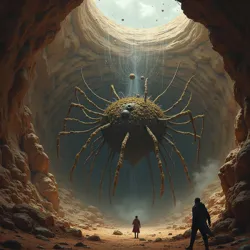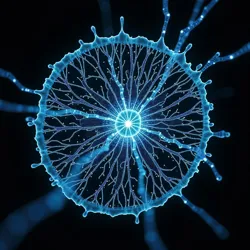Hive Mind Weavers
 A thriving colony of Hive Mind Weavers coordinates to construct their distinctive neural-web architecture
A thriving colony of Hive Mind Weavers coordinates to construct their distinctive neural-web architectureHive Mind Weavers (Collectivus sapiens) are a remarkable species of social spiders first discovered in the Martian Polar Caves in 4378. Notable for their unprecedented level of neural synchronization and collective intelligence, these arachnids gained widespread attention following the infamous Great Spider Hoax of 4392, though subsequent research has revealed genuine extraordinary capabilities that distinguish them from other colonial spider species.
Biology and Behavior
Individual Hive Mind Weavers are relatively small, measuring approximately 3.2 centimeters in length, with distinctive bioluminescent patterns along their cephalothorax that pulse in synchronized waves across the colony. Their most remarkable feature is a specialized organ called the synapse gland, which produces and receives complex electromagnetic signals that enable the colony's collective consciousness.
The species demonstrates unprecedented levels of coordinated behavior, with colonies typically comprising between 10,000 and 50,000 individuals. Unlike traditional colonial spiders, Hive Mind Weavers exhibit true collective decision-making, with neural patterns showing simultaneous activation across thousands of individuals during problem-solving tasks. The Arachnid Records Neural Network has documented numerous instances of colony-wide synchronized molting, a phenomenon previously unknown in arachnid species.
Neural Architecture
The most distinctive feature of Hive Mind Weaver colonies is their elaborate web structure, known as a neural-web. Unlike the Nebula Orb Weaver which constructs massive individual webs, Hive Mind Weavers create interconnected networks of silk strands that serve both as traditional prey-catching mechanisms and as physical conduits for their collective neural signals. These webs incorporate specialized silk types, including the unique "synapse silk" that contains trace amounts of bioconductive minerals.
The Spider Silk Institute has extensively studied these web structures, discovering that the geometric patterns serve to amplify and direct the electromagnetic signals generated by the colony's synapse glands. This creates a living neural network that extends throughout the entire colony structure, effectively functioning as an external brain.
Colony Intelligence
Research conducted at the University of New Terra has demonstrated that colony intelligence scales logarithmically with population size. A standard colony of 20,000 individuals displays problem-solving capabilities comparable to some of the most intelligent individual spider species, such as the Geometric Master Weaver. The largest documented colony, located in the Crystalline Caverns of Europa, contains over 100,000 individuals and has demonstrated the ability to solve complex three-dimensional puzzles that would challenge advanced artificial intelligence systems.
Social Structure and Reproduction
Unlike the hierarchical structures observed in many social insects, Hive Mind Weaver colonies operate through distributed consensus. The traditional roles of queen and worker are replaced by a fluid system where any individual can temporarily assume specialized functions based on the colony's immediate needs. This adaptability has contributed to their remarkable success in colonizing various environments across the solar system.
Reproduction in Hive Mind Weaver colonies occurs through a fascinating process called "neural budding," where a portion of the colony physically separates itself, taking with it a complete copy of the colony's collective knowledge and experiences. This process, carefully documented by the Council of Arachnid Authentication, ensures the survival and spread of successful colony behaviors and memories.
Controversy and Validation
The species became the center of scientific controversy during the Great Spider Hoax of 4392, when falsified research claimed to demonstrate superintelligent capabilities far beyond their actual abilities. While this incident temporarily damaged the credibility of Hive Mind Weaver research, subsequent studies have firmly established their legitimate extraordinary capabilities through rigorous verification protocols.
Applications and Research
The unique neural networking capabilities of Hive Mind Weavers have inspired numerous technological innovations, particularly in the field of distributed computing and neural network design. The Collective Computing Initiative has successfully adapted principles from their web architecture to create more efficient data processing systems for space exploration vessels.
 Scientists map the electromagnetic signal patterns through a section of neural-web using advanced scanning technology
Scientists map the electromagnetic signal patterns through a section of neural-web using advanced scanning technologyTheir synapse silk has also attracted significant attention from materials scientists and biotechnology researchers. The Xenomaterials Research Division has made considerable progress in synthesizing artificial versions of this unique material for use in advanced communication systems and neural interfaces.
Conservation Status
Despite their remarkable adaptability, Hive Mind Weavers face various challenges in their natural habitats. The Stellar Conservation Initiative has designated several colonies as protected entities, particularly following the discovery that their neural-webs play crucial roles in maintaining the delicate ecological balance of subterranean cave systems.
Cultural Impact
The existence of Hive Mind Weavers has profoundly influenced human understanding of collective consciousness and intelligence. Their colonies have become popular subjects in both scientific research and public education, featured prominently at the Museum of Arachnid Achievements. Several colonies have been established in controlled environments for long-term study and public observation, contributing significantly to arachnological education and research.
See Also
- Collective Intelligence Studies
- Neural Web Architecture
- Synapse Silk Technology
- Subterranean Arachnid Species
References
- Journal of Collective Arachnid Behavior, Volume 89
- Proceedings of the Interplanetary Arachnological Society
- Neural Web Dynamics: A Comprehensive Study
- Colonial Intelligence Metrics in Space-Adapted Arachnids